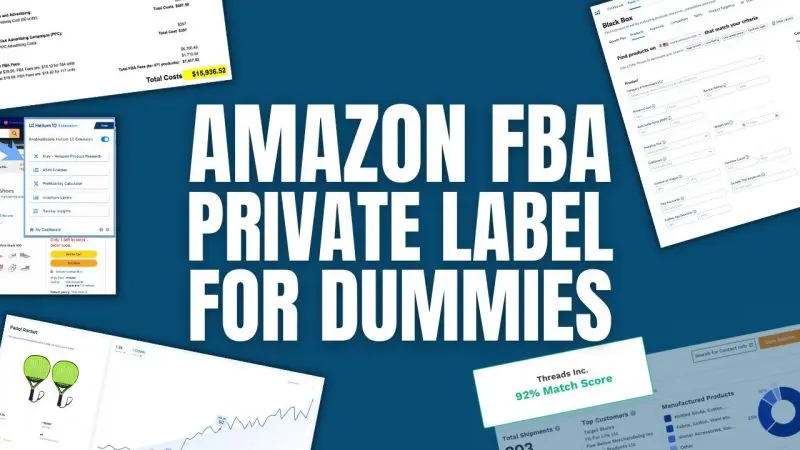Have you ever wanted to sell your own product? Who wouldn't want something that can make money 24/7 and scale to 7, 8, or even 9 figures in sales? Creating a private label brand is one of the best paths to making this a reality. If we use Amazon's FBA program, we can go even further with our product and scale tremendously without needing a warehouse, manufacturing plant, or any of our own traffic.
In this article, I'm going to share everything that you need to know about getting started with a private label product business on Amazon.
These are things that I've learned over a decade of selling on Amazon, bumping elbows with the biggest names in the business, and learning by making every mistake possible.
First, let's cover what Amazon FBA is, since it's a critical part of making private label work at the highest level, and then we'll dive into everything you need to know about using it for building your private label business.
What Is Amazon FBA?
Amazon allows 3rd party sellers to sell products on their platforms. These can be their own products or the products of other brands (this is done through retail arbitrage, online arbitrage, direct from supplier, liquidation, and wholesale sourcing models).
Sellers can ship the items to Amazon fulfillment centers where the products are stored until a customer orders them. When an item is purchased, Amazon preps and ships the product to the customer. They charge fees for this service that are deducted automatically.

Yes, Amazon fees can feel relatively high, but the benefits far offset them for most sellers. (You can check out the different Amazon FBA calculators to work out fees in more detail).
We get to leverage Amazon's massive user base, their positive customer relationships, and their shipping and processing infrastructure to grow our businesses bigger and faster than would have ever been possible without them.
To say I'm a fan of Amazon FBA is a massive understatement.
Moving on...
What Is Amazon Private Label
Private label selling allows people like you and me to create our own branded items without needing to do any of the manufacturing. This is because the items are purchased from large manufacturers overseas. Typically, this manufacturing happens in China.
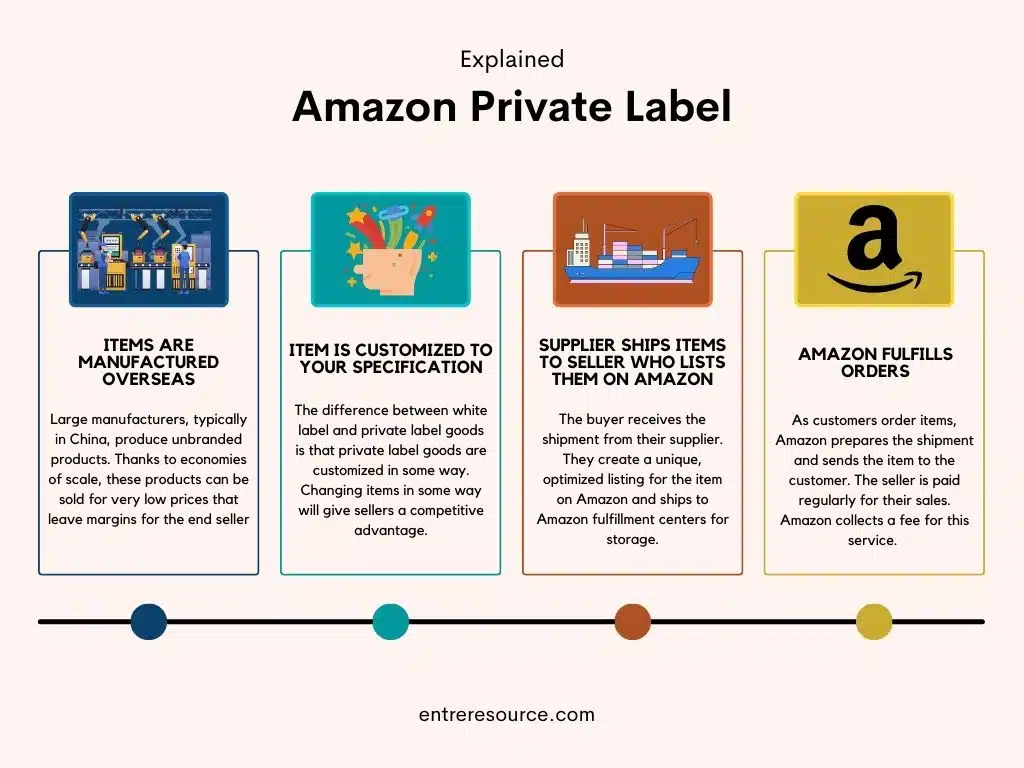
These items are not branded, so we can take them and apply our own brand to them. Unlike the other Amazon selling models, you aren't selling a brand; you're creating one for an existing product.
Keep in mind, with private label, we are not launching invented products. Many people think that to have a product to sell it needs to be completely original and ground-breaking. That isn't the case at all.
We are going to create products that are most likely already on Amazon or have a very close alternative on Amazon. This is good because we can know for certain that people are interested in the item, and its risk of totally flopping are lower.
Private Label vs. White Label Goods
White label goods are similar to private label goods, and the terms are often used interchangeably, but they are not the same. Private label goods are customized by the buyer. This gives them a unique product that others cannot copy exactly. White label products are goods that are unbranded and unaltered. Anyone can put their brand on these and sell them. Many brands can sell them, and the only true difference is the brand name. In fact, Dollar Shave Club started out by white labeling razors that anyone else could buy. Private label is a better model in most cases because it's more difficult for other brands to compete.
The items are shipped either to the Amazon seller, to an Amazon fulfillment center, or to a 3rd party prep and ship center.
The items are then prepared and packaged for individual sale.
The items are listed on Amazon, and the inventory is sent to Amazon fulfillment centers. When a customer orders an item, Amazon prepares and ships the item to them on our behalf. We pay them a fee for this service.
Private label sellers then do ongoing work to ensure sales growth, such as regularly monitoring their listings, managing shipments, negotiating better prices with manufacturers, gathering reviews, optimizing their listings, answering customer support questions, and other admin tasks.
Is Amazon FBA Private Label a Scam?
Let me start by saying that the online gurus have absolutely given Amazon selling a bad reputation. There are many courses sold by 20 somethings in Lamborghinis that cost 1,000s of dollars that promise huge, passive income gains with Amazon private label but don't share the risks (more on those shortly).
There are also companies that sell "done for you Amazon storefronts" that have regularly made the news for ripping off their customers. The list of these gurus facing lawsuits seems to grow daily.
- Seth Kniep of JustOneDime has filed for bankruptcy after collecting over $30,000,000 in profits from sellers buying his automated storefronts that failed to deliver.
- KTS and Kevin David were hit with a 2.6 million dollar lawsuit by the FTC for various claims against their Amazon and crypto courses.
- Brett Bartlett (bible quoting protege of fellow prosperity gospel-esque guru Jim Cockrum) suckered millions of dollars from sellers who wanted a piece of his Dynasty Toys brand that turned into a pyramid scheme.
- Alpha bro Jeremiah "The Bull" Evans, a regular front runner for douche of the year, and his failed Amazon automation systems have, as of March 2022, over 51 complaints submitted against them to the Utah Department of Commerce’s Division of Consumer Protection. (But can you really feel bad for people who bought something from someone who calls themselves an alpha and nicknamed themselves "bull?" It was like he was trying to tell everyone from the beginning to run).
With that being said, Amazon FBA private label is absolutely a legitimate business model with high earning potential for those who are willing to put in the work required.
So, no, although there are scammy courses and done for you programs, Amazon private label selling is absolutely not a scam.
It is not a get rich quick or get rich for sure business model, and no $2,000+ course is going to buy your way out of doing the work.
How Much Money Do I Need to Start Amazon Private Label?
One big difference between private label selling and other Amazon selling models is the startup costs are typically higher with private label.
Let's break down the costs a bit, and then I'll tell you how much I suggest you set aside before getting started.
- All Amazon sellers will pay $39.99/month for their professional selling account, but that is one of the smallest costs.
- You'll also pay Amazon fees that will vary depending on the type of item you sell, its price, and how large it is. This expense will not be fixed and will only occur when an item is sold.
Although you can do most things on the cheap, various expenses that you might have will include...
- Product sample orders
- Product shipping fees and customs
- Logos and brand assets
- Quality product photos
- PPC ads (pay per click)
- Review generations campaigns (you cannot buy reviews, but you can spend money on campaigns to get them organically through methods like giveaways and promotions.)
- Dead inventory and unfulfillable returns
- Amazon storage fees
- (Optional) Chinese Sourcing Agent
- Software like Helium10, Jungle Scout or some alternative that help in product research and optimization. These are technically optional, but it's silly and borderline wreckless to source without using the powerful tech we have available to us. The same goes for inventory management software, but only once your Amazon business is big enough.
Although the number varies depending on who you ask, I recommend that you should have at least $10,000 that you can afford to lose before starting a private label business.
Although the average number from a survey by Jungle Scout was much lower (most spent under $5,000 to start), I think $10,000 is the sweet spot for private label. It gives you the money you need to really do it right.
This money will be used to purchase your first bulk orders and cover other costs that will add up in building your brand and launching your first marketing campaigns to sell your new product.
Here's an example cost breakdown for an Amazon FBA Private label product from my friends over at Jungle Scout.
Note: These costs were from 2016, so I updated some of them to better fit the present fees.
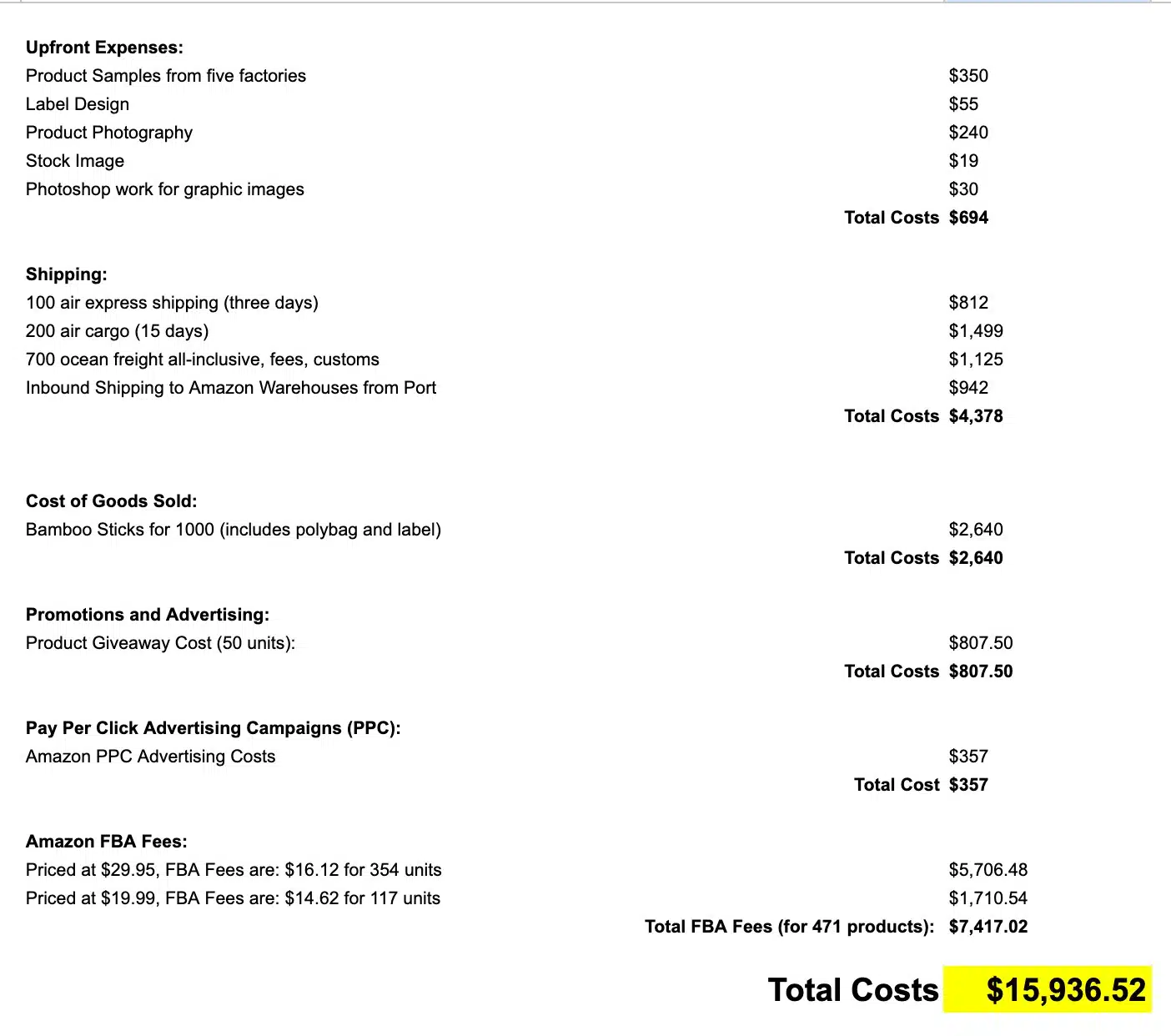
How Much Can You Make with an Amazon Private Label Business
Not to be dramatic, but you can really earn as much as you want.
Here are some interesting Amazon sellers statistics, once again, from my friends at Jungle Scout. Here are the reported lifetime earnings (not just revenue) of
| Income Range | Percentage |
|---|---|
| Under $25,000 | 62% |
| $25,000-50,000 | 6% |
| $50,001-100,000 | 5% |
| $100,001-500,000 | 6% |
| $500,001-1,000,000 | 2% |
| $1,000,001-5,000,000 | 1% |
| $5,000,000-10,000,000 | 0% |
| Not yet profitable | 9% |
| Don’t know | 9% |
Profit margins will vary, but most sellers report earning at least 10% on their items.
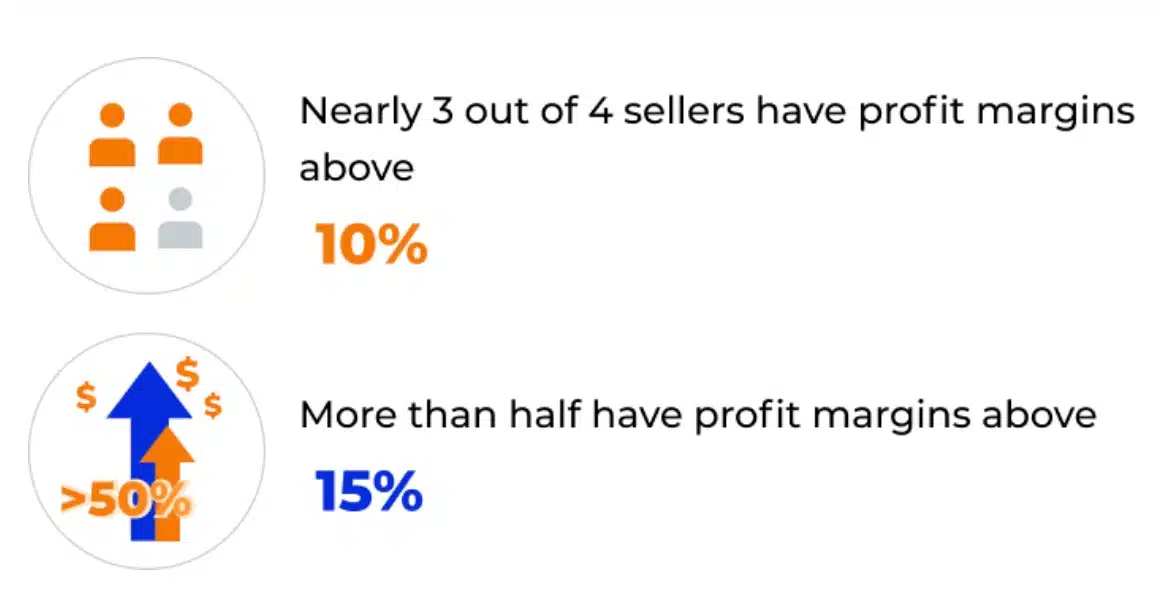
10% is pretty low for a successful private label item, and I believe this number might be skewed by many reporting 0% or below because of failure to launch.
I've known sellers like Steve Chou who have margins over 90% and others who are well over 50% across many different products.
You can crunch the numbers yourself to see how much you can earn.
How Much Work Is Required to Run a Private Label Business?
Private label is not a hands off business model. Although it can be low maintenance once it's been launched, and the tasks involved can be outsourced relatively easily, there is still quite a bit of ongoing work involved and a large amount of work upfront.
76% of Amazon sellers polled stated that they spend less than 20 hours per week on their business. Anticipate at least that much before you get started.
How Risky Is Amazon Private Label Selling?
Selling on Amazon is a double-edged sword. On one hand, you get access to the world's largest online shopping platform. You get to leverage the trust of the Amazon brand and capitalize on the Amazon Prime program that boosts sales tremendously. But it isn't without its risks.
Here are some of the private label risks that Amazon gurus selling expensive courses might not tell you.
- Account suspension
- Competition
- Supplier issues
- Complete failure to launch
Let's break down each of them further.
Risk #1 Account Suspension
When you sell on Amazon, you are at the mercy of Amazon. They can choose to suspend your account if you violate their terms of service. Although you might think, "I'll just be sure to not violate their terms of service," you'd be surprised how many sellers get suspended who thought the same.
Amazon can suspend you for several reasons. If a seller claims your product injured them, for example, you can become suspended immediately. This seems avoidable, but we can't always control what customers say or do. Some buyers will make claims like this in order to get a refund.
Although a suspension isn't a death sentence, and Amazon works with sellers in most cases to reinstate their accounts successfully, it can be an expensive holdup.
Risk #2 Competition
Amazon private label is brutally competitive. It's easy for other sellers to see which items are doing well and reverse engineer how to jump on the opportunity. Private label goods are generally easy to find, and most suppliers don't make exclusive deals with their buyers.
This is why having the manufacturer do something different with your items is so important.
Risk #3 Supplier Issues
Suppliers can change their prices, go out of business, or start to slack on the product quality that you expected. Since you don't own the warehouse and manufacturing infrastructure, you are beholden to them to remain consistent.
If a supplier raises their prices, it's not the end of the world. You can always raise the price on your listing, but it's far from ideal.
Risk #4 Complete Failure to Launch
Don't let the success stories blind you to the reality that many sellers fail at private label. Since the startup cost is high, so is the cost of failure. If you purchase thousands of dollars in inventory, and your listing doesn't sell, you can be stock with some serious sunk costs.
Pros and Cons of Private Label
Are you still interested in starting a private label business?
If so, let's get into how to actually get started.
Creating Your Amazon Storefront
You need to create an Amazon professional seller account before moving forward. The process is straightforward, so I won't go into step-by-step detail.
Set up your storefront here. Remember, you will need a Pro Seller plan that will cost $39.99/month.
Finding Your Private Label Product and Niche
Now, the fun part, finding your product!
Instead of jumping straight into your product idea, I highly suggest that you start with a niche you're going to target. Although we will start with launching one item, we want to find a niche that has the potential to be a full product-line, not just a one off product.
A product line will allow you to scale more easily. You can sell more products to your existing customers. Existing customers are your best future customers. Someone who has purchased from you once will be more likely to purchase from you again.
Companies have a 60-70% chance of selling to an existing customer vs. a 5-20% chance of selling to a new customer. [Source]
Also, when you grow your brand off Amazon, having a line of products makes creating a viable online store easier. Customers will load up their virtual carts with other related goods, since they're in the market and clearly in a spending mood.
Let's start with some tips.
Brainstorming
The most basic form of product and niche research is as simple as taking a piece of paper and a pen and mind mapping different product ideas.
Write down niche ideas, and then consider some product ideas that would work well in that space.
This is NOT a method that should be used on its own. You need to use tools to research competition, demand, and pricing.
Trend Research
Using a free tool like Google Trends or a paid tool like ExplodingTopics.com, research what is trending. Start considering what types of items you could sell to the trending niches.
Here's an example I found from ExplodingTopics

Padel is a trending sport (it's basically miniature tennis), and creating products for that niche could be profitable.
However, just because something is trending doesn't mean that it's worth pursuing, but it's a good place to start.
Amazon Specific Product Research
Head over to Amazon and browse around. Dig deeper into Amazon categories and sub categories for inspiration. You can do this manually, or you can use a website that most experienced sellers are familiar with, Keepa.com.
Keepa shows us something called a "Category Tree" that allows you to see every Amazon category and sub-category as well as how many items are in each of them. You'll find categories you might have never considered before.
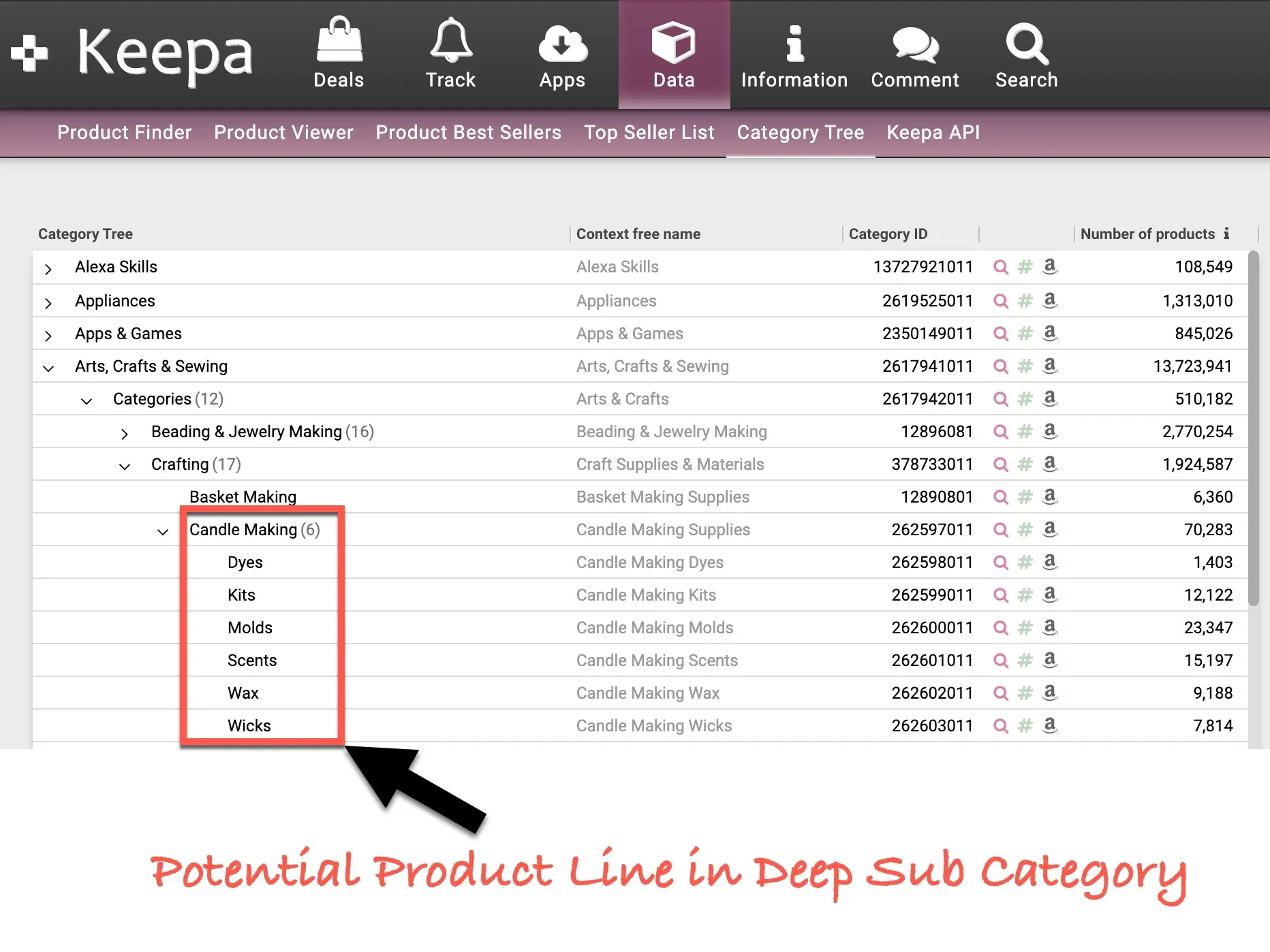
Use Amazon's suggested search recommendations as inspiration as well. Type in a keyword like "English bulldog" and see what other phrases it suggests.
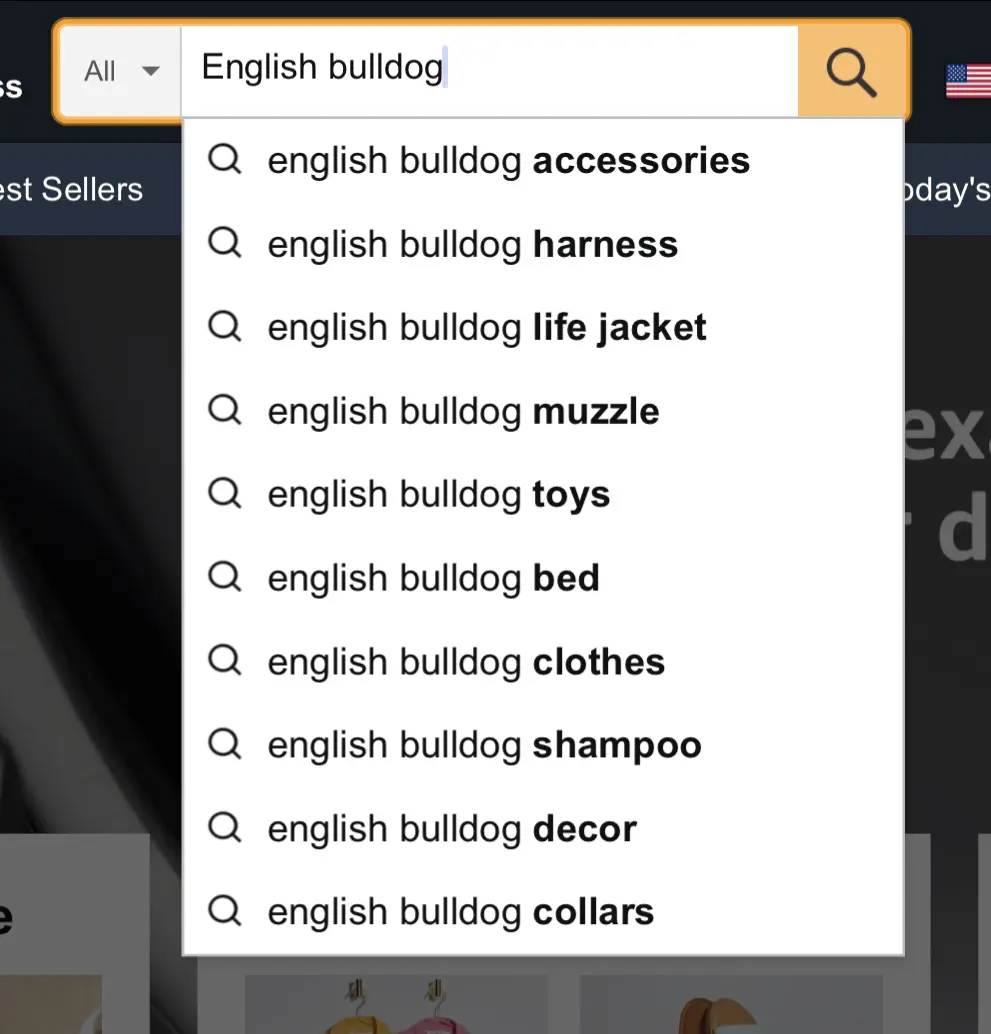
These auto fill results are far more meaningful than they appear on the surface. Amazon is smart, and they employ some of the brightest minds in tech and advertising to optimize conversions on every facet of their website.
These auto fills are most likely generated with terms that are most likely to lead to sales. If it appears in the auto fill, it's likely making sales.
Using the Helium10 Chrome Extension
Helium10 offers a free Google Chrome Extension that will help you see important details about products on Amazon.com (or any Amazon marketplace).
This can help us reverse engineer what is already working on Amazon. Most private label products already have some sort of competitor or close competitor on Amazon, and by spying on them, we can get a better idea about how much we can make with our own products.
Here's how to use the Chrome extension to do this.
Step #1 Install the Free Extension Here
Step #2 Navigate to an Amazon Product Page of Any Kind
Step #3 Click on Chrome Extension Icon to See Statistics
Step #4 Repeat for Different Niches and Products
Step #5 Create a List of Potential Items
We'll then use this list to find potential suppliers and calculate costs.



Spend a great deal of time on this part of the process. Make your list of potential products as long as possible, and you can narrow it down later.
Build a list of potential products that is as long as you can make it.
Product Sourcing Tips and Considerations
Here are some quick product sourcing tips.
Tip #1 Do NOT Simply Follow Your Gut
Follow the data. It is highly unlikely that your first product idea will be a winner. Remember, just because it interests you, doesn't mean it will be profitable.
Tip #2 Safety First
Avoid selling products that have a high risk of causing injury or illness. Even if these are commonly sold goods, they are risky.
Tip #3 Less Is More
The fewer pieces an item has, the less risk you'll have of product quality issues. The smaller and lighter the item is, the less it will cost to ship.
Think small and simple vs. big and complex.
Good vs. Bad Private Label Products
Good
Bad
Software for Private Label Sellers
Although it is another expense, you are crazy if you don't invest in the 3rd party tools available to help with your private label business.
Here are the top tools you should check out.
- Helium10 [Top Recommendation]. Read more about Helium10 here.
- DataDive
- SellZone [Helium10 Alternative] . Read more about Sellzone here.
- Jungle Scout[Helium10 Alternative]. Read more about Jungle Scout.
- Keepa. Read more about Keepa here.
- Exploding Topics. Read more about exploding topics here.
- FeebackWhiz. A powerful software built to help you get more reviews (which means more sales).
- Rebaid. A deal website that helps sellers get early sales to their products through Amazon compliant discount offers. Read more about rebaid here.
There are many others, but these are the big names to check out.
Finding Your Private Label Supplier
You can find product manufacturers in a number of ways. Here's a list of manufacturers that you could consider looking into to start. Obviously, I haven't worked with all of these, so do your own due-diligence.
Method #1 Reverse Engineer Suppliers with Jungle Scout
Whenever a shipment is imported into the United States, it is documented and available via public record. Tools like Jungle Scout have databases of these shipments, so we can reverse engineer where our competitors are getting their goods from.
Remember when I said that private label was brutally competitive? Well, here's one example why!
Jungle Scout outperforms Helium10 when it comes to supplier searching. Their supplier database lets us see things like competitor's suppliers and suppliers who might offer an item we're considering.
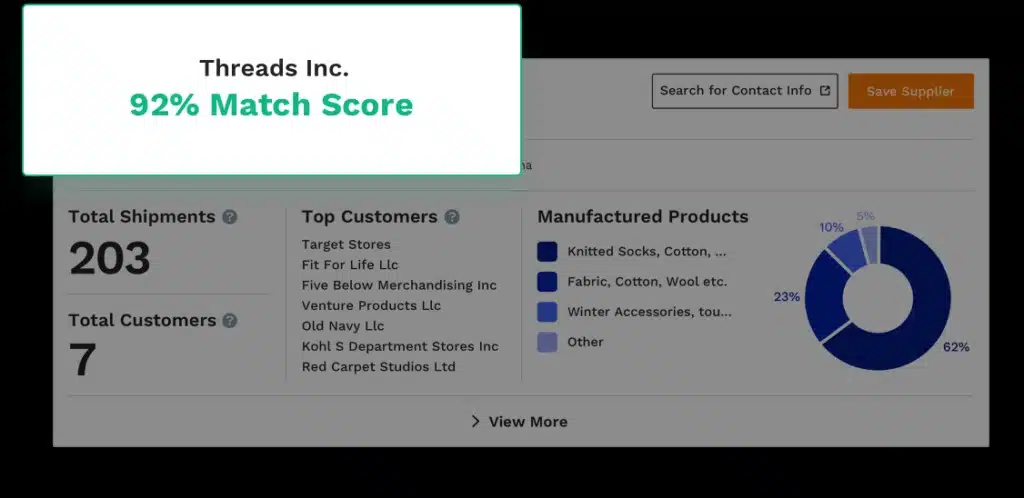
Jungle Scout will cost you about $49/month for a basic plan, but it's well worth it when you're searching for your first product and manufacturer.
Method #2 Chinese Sourcing Agent
Chinese sourcing agents are 3rd party intermediaries who can help connect US based Amazon sellers with Chinese manufacturers. They understand the language and culture and are often well versed in which companies are worth working with and which are not.
These agents can help screen suppliers, help with quality control, and negotiate prices with suppliers.
Here is a list of the top Chinese sourcing agents from my good friend at MyWifeQuitHerJob.com, Steve Chou.
- Imex Sourcing: https://www.imexsourcing.com/
- Foshan Sourcing: http://www.foshansourcing.com/
- Sourcify: https://www.sourcify.com/
- China2West: https://china2west.com/
- LeelineSourcing: https://leelinesourcing.com/
- SupplyIA: https://www.supplyia.com/
- Dragon Sourcing: https://www.dragonsourcing.com/
- Lazpanda: https://www.lazpanda.com/
- Guided Imports: https://www.guidedimports.com/
- Maple Sourcing: https://maplesourcing.com/
- Baysource Global: https://www.baysourceglobal.com/
- Jingsourcing: https://jingsourcing.com/
- Meeno Group: https://www.meenogroup.com/
- Sourcing Bro: https://sourcingbro.com/
- B2C Sourcing: https://b2csourcing.com/
- Linc Sourcing: https://www.lincsourcing.com/
The only downside is the cost. These agents typically charge 5% of the total cost of your goods purchased, and you cannot cut them out of the deal once it's complete. This is good and bad. It's good because they don't get paid (usually) unless they help you land a deal. It's bad because the cost can add up, and it will come directly out of your profits.
Method #3 Google Search
Yep, a good ol' fashioned Google search can be quite effective. Type in something like product type + supplier.

You'll get a lot of results. Alibaba will dominate the search engines if they have the product available. If you want, you can do a Google search exclusion and add "-alibaba" to the search.
Looking into Your Potential Supplier
Here are the key points to review when researching a supplier.
- Verify delivery time and product condition standards.
- Calculate total manufacturing costs and ensure there are no hidden fees.
- Review policies for quality control and guarantees.
- Read reviews from past customers.
Once you feel that all of the above meet your expectations, you can create a sample order. Ensure that you get more than a couple of units.
How to Create Your Private Label Brand Assets
Your private label brand will need the following.
- Packaging design
- Brand logo
- Product photos for your listing
You can do these in house if you have some design and/or photography skills, or you can outsource them to a company like 99Designs, Upwork, ThriveProductStudio, or even Fiverr.
Listing Your New Amazon Product
Once you've opened your Pro sellers account, found your product, created your branding, and finalized all the logistics, you can list your item.
Here’s how to list a brand new product on Amazon
Step 1: In Seller Central, navigate to “Add a product”
Step 2: Click “I’m adding a product not sold on Amazon.”
Step 3:: Select your product category
Step 4: Enter your product information
Next you’ll enter the key information about your new product. This will be things like your product name, it’s price, your brand name, who the manufacturer is, images, fulfillment type, UPC, and more. Don't worry about optimizing the listing, price etc. at this point. We will cover that in more detail, and you shouldn't rush this part of the process.
Note: All barcodes for Amazon products must be purchased from GS1. Amazon will check with GS1 to verify the UPC you enter. Read this article to learn more about obtaining your first UPC codes.
Once you complete the processes above, click on “Save and finish.” Congrats, your item is now listed on Amazon (although it is still pending approval).
Pricing Your Product
Like I mentioned at the beginning, I suggest sourcing goods that you can sell for between $19 and $49 dollars.
When deciding on pricing between that, let the market guide you in deciding what to price your product at. There is no perfect answer to what you should price your goods at, but just be sure that they will be able to sell at your desired price before you invest in your first shipments.
See what the current market is for similar goods, especially on Amazon.
Give yourself some wiggle room in case you need to reduce your price. I highly recommend that you avoid products that have slim net profits because they limit your ability to adjust price downward if need be without losing all profitability.
Read this article for more information about pricing your Amazon listing accurately.
Creating an Optimized Amazon Listing
A great listing is critically important to the success of your Amazon private label product.
Amazon SEO (search engine optimization) is the process of creating a product listing that ranks well for search terms in Amazon. A great listing will ensure that your product has a better chance of appearing organically at the top of search results and therefore, drives more organic sales.
I highly recommend that you either higher someone to create your Amazon listing for you, or that you use a premium tool like Helium10 to ensure your listing is as optimized as possible.
This includes, but is not limited to:
- Relevant keywords
- Multiple, high quality product photos
- A descriptive title
- Bullet points that explain and sell the product
- Product pricing
- Detailed description
- Backend search keywords
- The use of A+ content
Here's an article from Amazon themselves about Amazon SEO for your product listings.
Running Paid Ads to Your Private Label Products
I couldn't write an article about Amazon private label without talking about PPC (pay per click). It seems to be often overlooked, but almost every successful private label seller I've met leverages Amazon's PPC program. I don't understand why someone wouldn't.
With Amazon PPC, we can pay to have our product show up at the top of search results for terms that could sell our product.
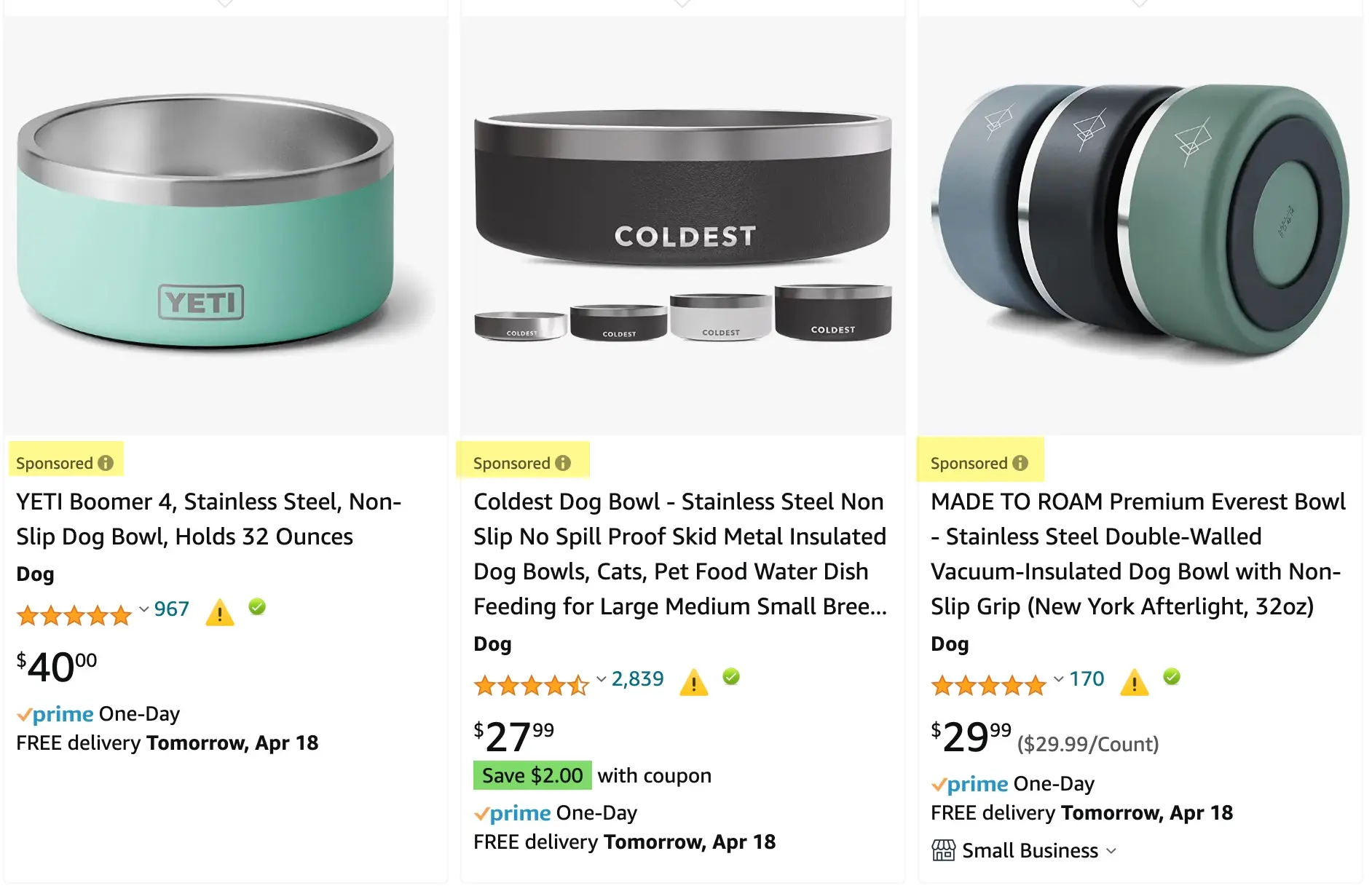
There are 3 types of Amazon PPC ads: sponsored product ads, sponsored brand ads, and sponsored display ads.
The cost per click varies depending on many factors. Amazon has an ad dashboard that will show you things like ACOS (Average Cost of Sale) and ROI so you can tell if your ads are converting and are profitable.
The rule of thumb is to keep your PPC spend around 10%-15% of your sales revenue. Some sellers will spend much more than that if they have good profit margins and the ads are converting well for them.
This topic deserves much more than one heading in this blog post, but for brevity, we will not go any deeper. You can learn more about Amazon PPC here though. Be sure to educate yourself thoroughly before spending big money on clicks.
About Amazon Private Label Reviews
Product reviews are a snowball effect. If you don’t have any reviews or very few reviews, buyers browsing listings are likely to pass over your product for another.
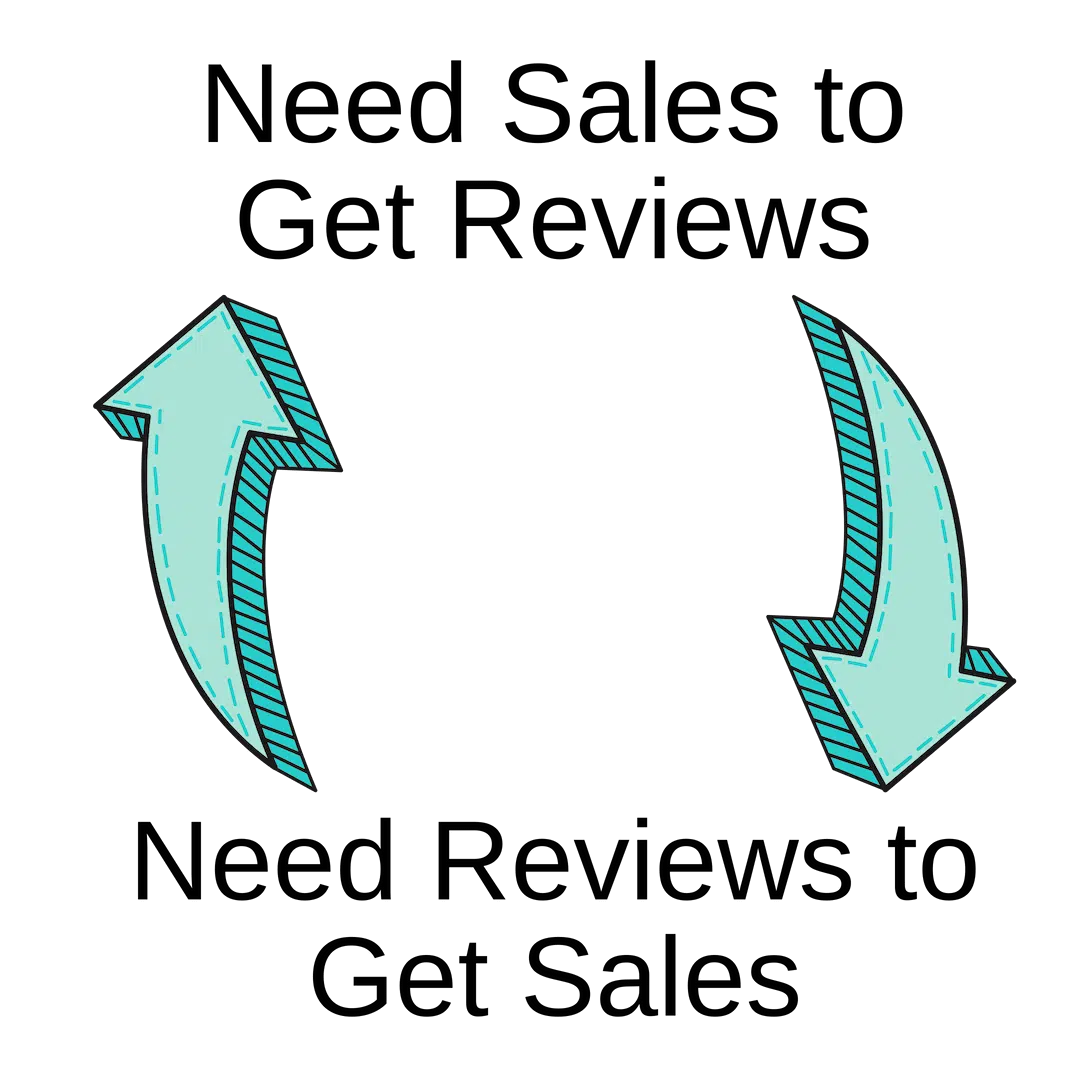
Getting off the ground is hard, but reviews have a snowball effect. Once you gather some, you gain momentum that continuously builds off itself. Build a few reviews, and more people will take a chance on your product, meaning more sales. More sales means more reviews, which means more sales, which means more reviews… you get the idea!
People naturally gravitate toward items that already have reviews–the more the better. Several reviews mean several people have already purchased the item and taken the risk that the potential buyer doesn’t have to take.
The overall star average, while decided by Amazon’s complex algorithms, also has a profound effect on the buyer’s mind. In seconds, a buyer consciously or subconsciously can decide if they’re interested or not just by glancing at the image of how many stars are in your listing.
Product Reviews vs. Seller Feedback
Seller feedback is the rating that your buyers leave on your seller profile. It’s supposed to be for your buyers’ satisfaction with your customer service and communication, how long it took you to ship the product (if FBM), etc. as a seller. It’s NOT supposed to be for anything related to a product review, such as their thoughts on the features of the product they bought. All of your seller feedback contributes to your overall seller rating, which will say, for example, “99% positive rating in the last 30 days” when buyers see you in the “available sellers” pane.
Product reviews are reviews specifically about the product’s features, design, functionality–anything the buyer would consider if they saw it in a physical store. They’re not worried about the reputation of the seller, just about the item itself. This is what we’re focusing on today.
How to Get Reviews on Your Amazon Products (Compliantly)
Two of our favorite techniques for building remarketing lists and encouraging reviews are using ManyChat and product inserts directly inside your product packaging. The two can work wonderfully together, but we’ll break them down separately.
Create an Amazing Product
None of the other methods for collecting positive reviews will work if your product stinks. You don't need to change the world with your product, but it should do exactly what you say it does and leave customers satisfied.
Offer Fantastic Support
Although seller feedback and product reviews are not the same, customer support can increase the likelihood of an overall positive experience and positive product review. If a buyer leaves seller feedback on an Amazon product, you can have it removed easily.
Read my article about offering world class customer support here.
Amazon Vine
Amazon does not allow incentivized reviews, but their built in Vine program is about as close as you can get to that. It costs $200/Parent ASIN.
To qualify for the program, you must be brand registered, sell only new products, and have a listing with fewer than 30 reviews.
The intent of the program is to give brand new products the boost that they need. Amazon understands that it's difficult to get your first reviews, so this program helped combat that.
Use ManyChat
ManyChat is an automated service that works through Facebook Messenger. With ManyChat, you set up a bot that sends auto responses and prompts to customers. It’s a handy initial contact tool that helps you engage customers without you having to write individual messages to each one.
ManyChat is also great for encouraging customer reviews, and product inserts (which add a human touch) can be a “tangible” way to direct customers to the ManyChat funnel. Many sellers use product inserts (with or without ManyChat) to engage their customers and assure them that their satisfaction is important to them (well, to you, as the seller).
The human touch is always a good way to establish that desired emotional connection; your customers will feel less like they’re ordering from a gigantic consumer goods aggregate and more like they’re purchasing from an actual human. This naturally makes them feel more inclined to leave a review.
REMEMBER: Never use language that explicitly asks for positive reviews. Amazon considers this review manipulation and is very strict in enforcing it. Violation of review manipulation policies may cause consequences as severe as seller account suspension.
Use FeedbackWhiz
FeedbackWhiz is a tool that helps Amazon sellers get more positive reviews and remove negative ones.
Although positive reviews are great, negative reviews can be devastating to a new brand. This is where tools like FeedbackWhiz come in handy.
FeedbackWhiz allows sellers to control the entire feedback and review process from one clean dashboard.
- Stay on top of incoming customer feedback. Get instant notifications for neutral and negative feedback.
- Respond quickly, satisfy frustrated customers, and receive alerts whenever negative feedback is removed.
- Use the feedback management tools to create email campaigns that maximize your chances of customers removing negative reviews without violating Amazon’s Terms of Service.
- Create automated, personalized email campaigns that help boost positive reviews and avoid negative ones.
You can try FeedbackWhiz for free for 30 days here.
Scaling Beyond Amazon
Do you know one of the most beautiful parts of having your own brand? You can sell your products anywhere.
Branching beyond Amazon will also give you more security in the event that they suspend your account at a given point.
This means you can create your own website, typically with Shopify, and then drive your own traffic to it. You can still use Amazon to fulfill your orders if you'd like, or you can fulfill them yourself or through another 3rd party to save on costs.
You can crosslist your items on up and coming 3rd party marketplaces like WalMart or established ones like eBay,
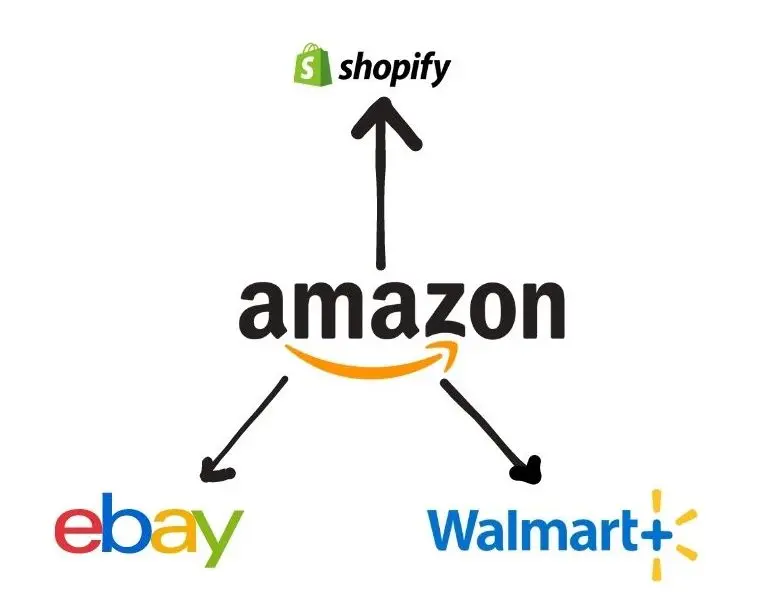
You can run ads to your products via Instagram, YouTube, Facebook, TikTok ads, and anywhere else you want.
You'll find that you're able to better track conversions and retarget your customers when you work outside of Amazon.
You can create an affiliate program and pay influencers to promote your products on their channels.
Adding your own off-Amazon-presence to your brand will also make it more valuable in the eyes of investors.
Which brings me to our next topic!
Selling Your Amazon Private Label Business
Maybe I should have led with this, but you can sell your private label business for millions of dollars.
Don't believe me? Go check out a site like Empire Flippers and see how much the Amazon storefronts are selling for. Click here for a shortcut.
Storefronts sell at multipliers around 30x to 48x the monthly profits. A storefront making $10,000/month in profit can sell for $300,000 to $480,000.
I wrote more about selling Amazon businesses here.
Final Word and Suggestions
There you have it, Amazon private label in a nutshell. Of course, there are small pieces that you'll have to learn as you go. Here's what I recommend to improve your chances of private label success.
#1 Join seller communities (free or paid)
#2 Read, watch, and listen to as much content on the topic of Amazon selling as possible
#3 Take serious action and don't look back!
Here's to your success.

